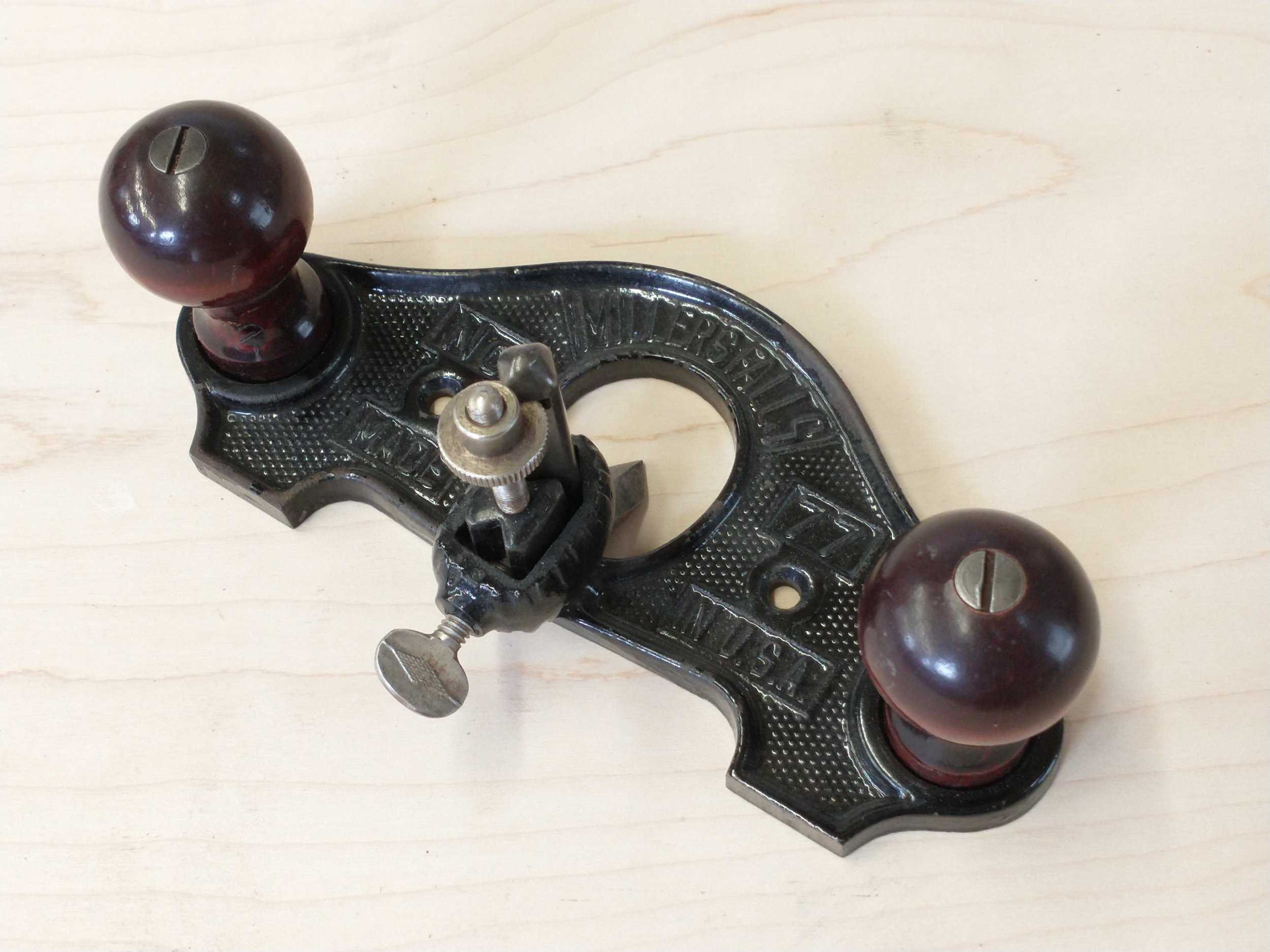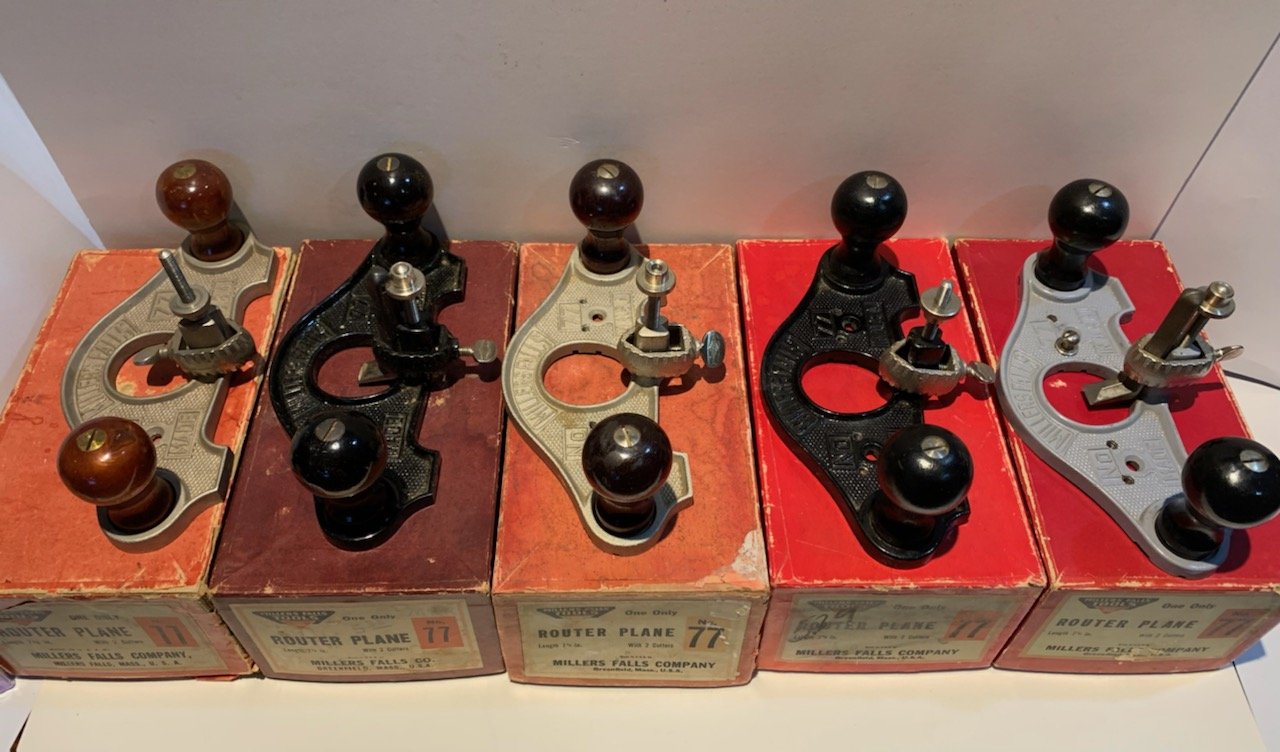
No. 67 Open Mouth Router Plane
No. 77 Closed Mouth Router Plane
|
Model: |
67 Open Mouth |
77 Closed Mouth |
|---|---|---|
| Manufactured: | 1929 to 1964 | 1929 to 1961 |
| Sole Length: | 3-5/8” | 3-5/8” |
| Sole Width: | 8-3/8” | 8-3/8” |
| Iron Width: | 1/4”, 1/2", Pointed | 1/4”, 1/2", Pointed |
| Weight: | 2.0 lbs | 1.8 lbs |
| Adjustments: | Threaded Nuts | Threaded Nuts |
| Casting Body: | 368 | 373 |
| Cross Reference: | Stanley No.71 | Stanley 71-1/2 |
No. 67 and No. 77
This page will have four sections. The first section outlines the features that are common between the two routers. The next section will show what is unique about each. The third section will attempt a timeline based on features known to exist at certain times. The catalogs do not help with this effort because Millers Falls was notorious for not updating the description even if it changed. The last section will be a gallery of examples.
The Millers Falls name is embossed across the front of both planes. On the No. 67, the name is across the bridge in the front. Under the name on either side of the opening is the model number. In the back of the bed on either side of the receiver post is “MADE” , “IN U.S.A.”. The castings on the bed will never change while these tools are in production.
The depth-of-cut is controlled by a round adjustment nut that slides into a grove at the top of the cutter. This adjusting nut traverses on a threaded rod which is mounted on the top of the receiving post. The receiving post has a “V” grove on both the front and back. This grove allows the cutter to be positioned facing the back for bullnose work or facing the front for regular work. The cutter is clamped to the receiver post with a collar that is tightened with a thumb screw.
Both routers have a countersunk hole to allow a larger custom wooden sole to be attached to provide more contact with the reference surface.
The two knobs will be attached with either a double treaded rod and a waist nut, or a single bolt. Both routers will have the same configuration though production.
The No. 67 open mouth router plane has a post and shoe combination what has two specific functions. The first is to close the throat for more support at the front of the router. The second function is to use the rod and shoe as a depth-of-cut indicator. This is done by allowing the rod with the narrow end down to move freely in the bridge support. Extending the rod below the sole at the desired depth, the shoe is secured against the top of the bridge. As the blade is lowered and shavings are taken, the shaft with the shoe attached will lower until the shoe contacts the bridge.
The No. 77 closed mouth router plane has the built in support for more support in the front, but it does not have any depth of cut indicator. If you go past your depth, get the shims.
A timeline for both routers
Over the years, I have observed as many as eleven different variations of these planes. Some of these planes may be crossovers, so I will stick to the eight known variations. The columns in the table below list both the minor changes like a finish change, and major changes like adding a fence or screw threads changing on both routers. It is not a timeline down to a specific year, but a known grouping of when certain parts changed. We know that a fence and the number of cutters changed in the1949 catalog. We also know a single bolt was used to secure the knobs through most of the forties. Around the early to mid-forties, the surface of the thumb screw changes from a plain surface to a stretched diamond design as well as the thread count from 1/4-28 to 1/4-20. What is not clear is when a finish changed on the body, clamping collar or knobs.
|
Fence |
Cutters |
Body |
Knob |
Bolt |
Clamp |
Thumb Scr |
Production |
|
No |
2 |
Nickel |
Rosewd |
Brass Waist Nut |
Nickel |
Plain |
1929 |
|
No |
2 |
Black |
HW-Mah |
Single |
Black |
Plain |
40's |
|
No |
2 |
Black |
HW-Mah |
Single |
Black |
Diamond |
40's |
|
No |
2 |
Black |
Black |
Single |
Black |
Diamond |
40's |
|
Yes |
3 |
Nickel |
HW-Mah |
NI Waist Nut |
Nickel |
Diamond |
1949 |
|
Yes |
3 |
Nickel |
Black |
NI Waist Nut |
Nickel |
Diamond |
50's |
|
Yes |
3 |
Black |
Black |
NI Waist Nut |
Nickel |
Diamond |
50's |
|
Yes |
3 |
Gray |
Black |
NI Waist Nut |
Nickel |
Diamond |
50's - 60's |

The No. 67 had different variations over the years. The one thing that was consistent was the quality of workmanship.

The earliest version of the No. 67 has a nickel body and parts, brass waist nuts with a double threaded rod and rosewood handles. Note the two countersunk holes to attach an extended wooden bottom are not completely drilled through.

This is an example of the No. 67 router plane in the forties when the limited resources in brass required the knobs to be attached with a single steel bolt. The bolt would have been blued to protect the surface from rust.

Configured as a depth stop with the shoe secured to the rod at the correct depth. The rod is allowed to drop with each pass. When the shoe bottoms out with the body, you reached the correct depth. The router will not stop you from continuing to make a deeper cut. If this happens, that 3 minute effort is now a 20 minute task with a shim and some glue. The good news is that no one will know the difference except you every time you look at that piece.

The iron can be mounted on the outside for work close to a vertical surface, or off the end of a board with more support.

This shows the two different thumb screws used on both the No. 67 and the No. 77. The top screw has a 1/4-20 thread and a stretched diamond on the surface (1942-1960's). The lower thumb screw has a 1/4-28 thread with a plain surface (1929-1942).

Starting around 1949, both the No. 67 and the No. 77 were configured to attach a fence to the sole.

The fence has an offset tongue with a center screw slot. It can be positioned as a straight cut guide, or a guide for curved cuts.

Routers that have the fence option can attach the fence on either the left or right side. The attaching screw can be positioned in the inner screw hole for a close cut to the edge , or the outer screw hole for a cut further from the edge. The fence will fit in either the top or bottom groove depending on how the fence is positioned and only one screw is needed to secure it.

This early version of the No. 77 with brass waist nuts and no fence.

This version was produced during WWII with a black body and collar. The mahogany finished hardwood handles are secured with a single bolt. No fence was supplied with this version. Also, note the diamond thumb screw which is new around the 1942/1943 time frame.

Some of the different variations of the No. 77

This version has a fence attachment with a black body and knobs. An example was found with an April 1951 ink stamp.

The April 1955 catalog has this plane as having a nickel body, ebony lacquered hardwood handles and a fence with three cutters.

Starting in 1956, Millers Falls changed the look on several tools to a gray finish.

